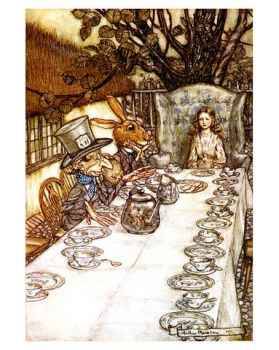DS#1 sent me an IM at work.
“Will you be home tonight? I need help with my Physics class.”
I had to take DS#2 and DD#2 out to buy shoes for school and pick up fruit and pumpkins at the grocery store, but I was home by 8:00 p.m. I warned DS#1 it had been a loooong time since I took Physics.
“Don’t worry, Mom. That won’t matter,” he reassured me. Then he handed me his take home test. “I need help with the last two questions.”
I read them. Then I read them out loud. It didn’t help.
“I know what a concept is. I know what a metaphor is in literature. I know what a cipher is. What do these have to do with Physics? And I have no idea what ‘Maya’s Veil’ is.”
DS#1 laughed and handed me his textbook. It was written by the instructor. I always hated when the instructor used his textbook because it means that if you didn’t understand the lecture, the textbook won’t be any help.
On the cover is a picture of the Hindu Goddess, Maya, superimposed on a series of triangles. I flip to the index.
“Don’t bother, Mom,” DS#1 says. “It won’t help. I tried that.”
He was right, so I began skimming the textbook from the beginning. In the notes, the author discusses his educational background: undergraduate degree from the Sorbonne; Ph.D. in Physics from a prestigious university (Heidelberg, if I remember correctly) in Germany.
“Tell me the truth,” said DS#1. “Do you think this guy is a pothead?”
Potheads don’t usually write 500+ page textbooks. Reading further, I discover that after graduation, the author went backpacking in Oaxaca, Mexico, with all twelve volumes of Nietzsche’s philosophical works. And the author ended up living in Mexico for six months and read Carlos Castaneda’s works.
“Not pot,” I answered. “Peyote.”
We eventually worked out answers to the test questions. I felt a little bit like Alice talking to Humpty Dumpty: the words mean whatever it is I decide they will mean. What this instructor/author/physicist is trying to do, I think, is bring together physics and metaphysics in a Grand Unification Theory of sorts. There is the known world of concepts, the unknown world of ciphers, and the world that bridges both of these, metaphors.
Just for fun, DS#1 asked Hubs to explain one of the paragraphs. Hubs read it and gave his pronouncement that it was meaningless bovine by-products.
This morning I was doing a web search, since I could not remember the title of the textbook, and what I found when I searched Google for “Maya and physics” astounded me. Apparently there really is serious scholarship linking (or trying to) physics to the Eastern Religions of Hinduism and Buddhism. The connection seems to be that, on the quantum level of physics, what appears to be solid and real is, in fact, insubstantial and unknowable. For example, we perceive, and therefore think, that a rock is stable. In reality, a rock is merely a bunch of buzzing atoms, filled with parts like quarks, electrons, protons, charm, etc., etc. We can know where a particle is and its size or we can know its velocity and direction. We can’t know all its size and its velocity.
Okay, so we can’t know everything about the Universe, including everything about ourselves. Seems to me that is what religion, in general, has always claimed. Apparently it is au courant, however, to focus on Eastern and/or mystical religions, such as the ancient Mayans, rather than Christianity. Curiously, in my search, all the papers were written by scientists with European last names and seemed to be all male. My guess, and it’s only that, is that Christianity suffers from being “too familiar” for these men and they are looking for something more exotic.
They are searching for meaning in their lives and in their research and, unlike Dorothy, have not discovered that the answers may be in their own backyard.
Thursday, October 27, 2005
Helping Out With Physics Homework
Posted by
March Hare
at
12:27 PM
![]()
Subscribe to:
Comment Feed (RSS)




|